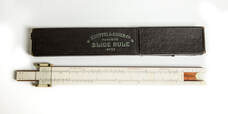Slide Rule
Another is a large yellow teaching slide rule that is 3-1/2 feet wide and approximately 8 inches tall. It is made to hang on a classroom wall for the students to see. It is a Pickett All American Quality model that has three extended cube root scales and is described as vector-type, linear duplex, with dual-base speed rule. The Pickett model was sold from 1958 to 1962.
Brief History
Galileo Galilei and John Napier made the precursors of slide rules dating back to the 1500s. Galileo invented the sector, which is a graduated ruler used to calculate squares, roots, cubes, reciprocals, and tangents. Napier invented logarithms in 1614. This led to the creation of the first slide rules by Anglican minister William Oughtred. His slide rules had both straight and circular-shaped versions. They calculated distance, multiplication, and division.
From the 15th century to the 18th century, slide rules were perfected upon for accuracy and were improved with the inclusion of a cursor. They are said to have led to the beginning of the Industrial Revolution.
The slide rule came to America in the early 19th century. It has been utilized in great historical achievements such as the building of the Golden Gate Bridge and in the Apollo missions. Advances in engineering, physics, and structural design led to the awareness of the limitations of slide rules. The four-function calculator succeeded it, and as computers and calculators came into popular use, the slide rules had their last runs in the 1970s.
Today, people may see 200 slide rules in the Smithsonian Museum of American History or read about many more at the online International Slide Rule Museum (ISRM). Avid collectors belong to the Oughtred Society.
Galileo Galilei and John Napier made the precursors of slide rules dating back to the 1500s. Galileo invented the sector, which is a graduated ruler used to calculate squares, roots, cubes, reciprocals, and tangents. Napier invented logarithms in 1614. This led to the creation of the first slide rules by Anglican minister William Oughtred. His slide rules had both straight and circular-shaped versions. They calculated distance, multiplication, and division.
From the 15th century to the 18th century, slide rules were perfected upon for accuracy and were improved with the inclusion of a cursor. They are said to have led to the beginning of the Industrial Revolution.
The slide rule came to America in the early 19th century. It has been utilized in great historical achievements such as the building of the Golden Gate Bridge and in the Apollo missions. Advances in engineering, physics, and structural design led to the awareness of the limitations of slide rules. The four-function calculator succeeded it, and as computers and calculators came into popular use, the slide rules had their last runs in the 1970s.
Today, people may see 200 slide rules in the Smithsonian Museum of American History or read about many more at the online International Slide Rule Museum (ISRM). Avid collectors belong to the Oughtred Society.
Donors
MOTAL’s Keuffel & Esser slide rule was donated in 2006 by a supporter. The teaching slide rule was given to MOTAL in early 2013 by a junior high math teacher who was retiring from her position.
MOTAL’s Keuffel & Esser slide rule was donated in 2006 by a supporter. The teaching slide rule was given to MOTAL in early 2013 by a junior high math teacher who was retiring from her position.
Learn More!
If you would like to learn more about the slide rule, we recommend the following:
If you would like to learn more about the slide rule, we recommend the following:
- "Keuffel & Esser 4055 Favorite Simplex Slide Rule" by National Museum of American History
- "Pickett N4-ES Vector-Type Log Log Duplex Slide Rule" by National Museum of American History
- "Slide Rule History" by The Oughtred Society


